

A Sphinx is a zoomorphic mythological figure which is depicted as a recumbent lion with a human head. It has its origins in sculpted figures of Old Kingdom Egypt, to which the ancient Greeks applied their own name for a female monster, the "strangler", an archaic figure of Greek mythology. Similar creatures appear throughout South and South-East Asia, and the sphinx enjoyed a major revival in European decorative art from the Renaissance onwards.
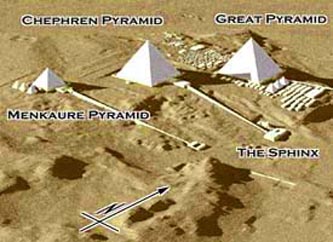
The Great Sphinx of Egypt, the largest and best known Sphinx, lies near the Great Pyramid in the Giza Valley Plateau, situated about six miles west of Cairo. It is the largest single sculpted statue in the world, carved from the bedrock of the plateau.
The Sphinx is oriented due east facing the rising sun near the 30th parallel, and may well be the oldest monument on the Giza Plateau since long-term water weathering has been found in the great pit in which it lays.
The Western name "Sphinx" was given to it in antiquity based on the legendary Greek creature with the body of a lion and the head of a woman, though Egyptian sphinxes have the head of a man. The ancient Greek term itself is postulated to be a corruption of the ancient Egyptian Shesep-ankh. This name was applied to royal statues in the Fourth Dynasty, though it came to be more specifically associated with the Great Sphinx in the New Kingdom.
In medieval texts, the names balhib and bilhaw referring to the Sphinx are attested, including Egyptian historian Maqrizi, which suggest Coptic constructions. The Egyptian Arabic name Abul-Hol, which translates as Father of Terror, came to be more widely used.
No one is certain when the Sphinx was built nor what it represents, though many theories about its origin and purpose have been noted. It is commonly believed that the Sphinx was built by ancient Egyptians in the 3rd millennium BC.
We do not known the name ancient Egyptians called the statue. It is referred to circa 1500 B.C.E. as Hor-em-akht - Horus in the Horizon, Bw-How Place of Horus and also as Ra-horakhty Ra of Two Horizons.
Carved out of the surrounding limestone bedrock, the Sphinx is 66 feet (20m) high, 241 feet (73m) long, and 63 feet (19m) wide, making it one of the largest single-stone statues in the world. Blocks of stone weighing upwards of 200 tons were quarried in the construction phase to build the adjoining Sphinx Temple.
The Sphinx faces due east, with a small temple between its paws. The temple resembles the sun temples that were built later by the kings of the 5th Dynasty.
The first attempt to dig it out dates back to 1400 BC, when the young Tutmosis IV, falling asleep beneath the giant head, dreamt that he was promised the crown if he would only unbury the Sphinx. The young prince immediately formed an excavation party which, after much effort, managed to dig the front paws out. To commemorate this effort, Tutmosis IV had a granite stela known as the Dream Stela placed between the paws. Ramesses II may have also performed restoration work on the Sphinx.
In 1817 the first modern dig, supervised by Captain Caviglia, uncovered the Sphinx's chest completely. The entirety of the Sphinx was finally dug out in 1925, to the great pleasure of its numerous visitors.
There are no inscriptions on, or in the Sphinx to indicate who built it.
The true origin and purpose of the Sphinx remains a mystery, and it is perhaps a puzzle which will never be fully solved. Despite its fundamental enigma, the image of the Sphinx remains in the mind of history as the keystone of ancient Egyptian civilization and a part of its religious beliefs.
The one-meter-wide nose on the face is missing. It has long been presumed that the nose had been broken off by a cannon ball fired by Napoleon's soldiers. However, sketches of the Sphinx by Frederick Lewis Norden made in 1737 and published in 1755 illustrate the Sphinx without a nose.
The Egyptian historian al-Maqrizi, writing in the fifteenth century, attributes the vandalism to Muhammad Sa'im al-Dahr, a Sufi fanatic from the khanqah of Sa'id al-Su'ada. In 1378, upon finding the Egyptian peasants making offerings to the Sphinx in the hope of increasing their harvest, Sa'im al-Dahr was so outraged that he destroyed the nose. Al-Maqrizi describes the Sphinx as the "Nile talisman" on which the locals believed the cycle of inundation depended.
In addition to the lost nose, a ceremonial pharaonic beard is thought to have been attached, although this may have been added in later periods after the original construction. Egyptologist Rainer Stadelmann has posited that the rounded divine beard may not have existed in the Old or Middle Kingdoms, only being conceived of in the New Kingdom to identify the Sphinx with the god Horemakhet.
This may also relate to the later fashion of pharaohs, which was to wear a plaited beard of authority - a false beard (chin straps are actually visible on some statues), since Egyptian culture mandated that men be clean shaven. Pieces of this beard are today kept in the British Museum and the Egyptian Museum.
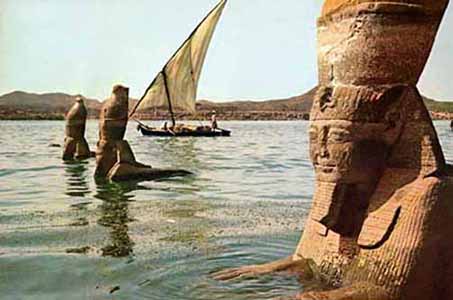
The head of the Sphinx was altered many times by the Pharaohs therefore it is best remembered with the head of a king wearing his headdress and the body of a lion. Many believe that the original head was that of the lion and the Sphinx dates to the Age of Leo - 12,000 years ago.
Based on the current head, many researchers have concluded that the Sphinx was built by the Pharaoh Khafre - Chephren in the 4th Dynasty around 2500 BC.
Interestingly the features of the face of the Sphinx bear a far more striking resemblance to an older brother of Khafre, the Pharaoh Djedefre - Radjedef.
In 1996, a NY detective and expert in identification, took various measurements of the size, angles and proportions of the head and concluded that it did not match known representations of Khafre's face. There was a greater resemblance to Khafre's elder brother Djedefre.
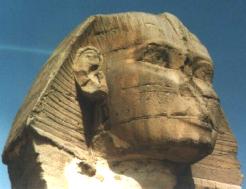
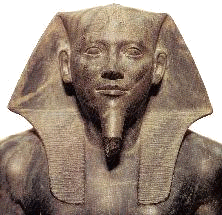
Djedefre's short lived reign occurred just prior to the reign of Khafre. Unlike Khafre, Khafre's father, and later Khafre's brother Menkara, Djedefre did not construct his pyramid on the Giza plateau. Instead Djedefre built his pyramid at Abu Roash where it now lies badly damaged. Some believe that Khafre usurped the throne of Djedefre and then built his pyramid and Sphinx at Giza.
The sphinx has been repaired many times due to erosion by water and wind. Some people believe that the Sphinx was painted and was quite colorful. Since then, the nose and beard have been broken away.
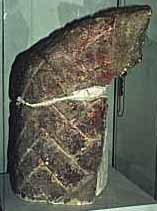
A piece of the original beard
The nose was the unfortunate victim of target practice by the Turks in the Turkish period. It is often erroneously assumed that the nose was shot off by Napoleon's men, but 18th century drawings reveal that the nose was missing long before Napoleon's arrival. Traces of the original paint can still be seen only near one ear.
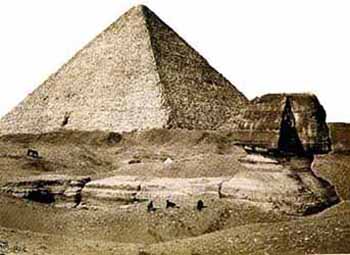
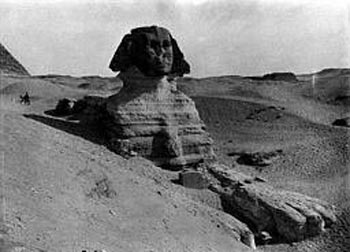
1895
In 1905 the sand was cleared away to expose the full body of the Sphinx. The head has been replaced by several different heads - the original the head of a feline cat.
The most recent period of restoration began in 2006. The cement which had been used in earlier attempts at restoration was now found to be causing problems. The statue is mostly constructed of porous limestone, which allows the passage of air. Because cement is non-porous and rigid, changes in the basic proportions of the statue were found to be occurring.
Over the years, casual observers, as well as at least one forensic expert have characterized the face of the Sphinx as "Negroid". One of the earliest known descriptions of a "Negroid" Sphinx is recorded in the travel notes of French scholar Constantin-Franois de ChassebÏuf, Comte de Volney, who visited in Egypt between 1783 and 1785. Volney described it as "typically Negro in all its features." Likewise, French novelist Gustave Flaubert traveled to Egypt in 1849 and recorded the following observation:
The New York Times subsequently published a letter to the editor submitted by orthodontist Sheldon Peck, who concurred with Domingo:
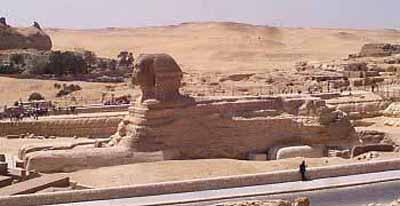
The paws are 50 feet long (15m) while the entire length is 150 feet (45m).
The head is 30 (10m) feet long and 14 feet (4m) wide.
It is 200 feet long and 65 feet high.
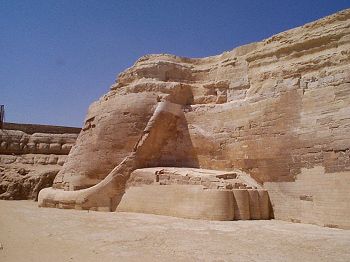
The Sphinx has a tail which wraps around the right hind paw.
The paw has been restored in recent years.
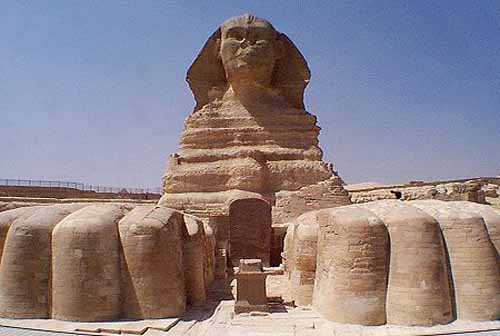
The Sphinx has a breast plate between its front paws.

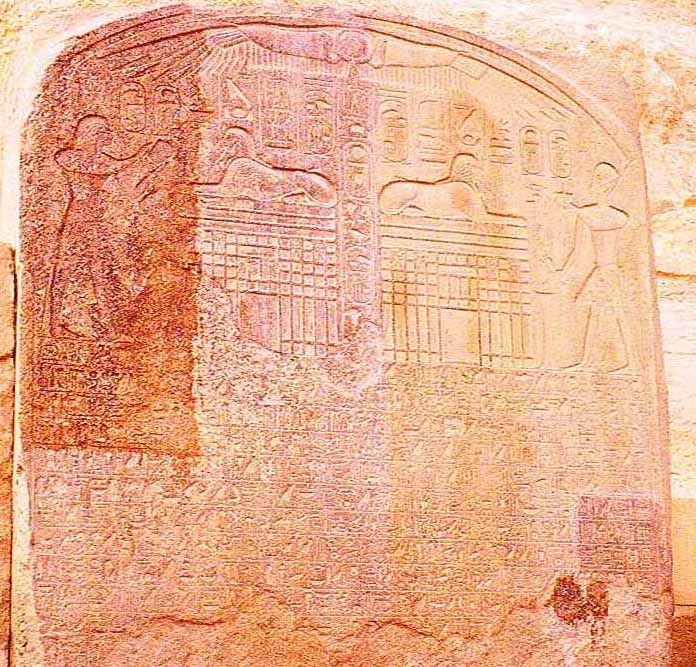
In the New Kingdom, the Sphinx became a symbol of kingship and many kings of this period built temples and stelae (Sphinx Breastplate tablets bearing inscriptions) in the area surrounding the statue. Amenhotep II built a mud-brick temple to the north-east of the Sphinx, and Rameses II, one of the ancient kingdom's most prolific builders, constructed an altar of granite between its paws. Ancient tablets also show images of worshippers presenting burnt offerings to the Sphinx.
There are many metaphors on the breastplate that following the formula for creation - separation in the physical - to ascension or resurrection of consciousness in the alchemy of time. The lions images, for example, facing in separate directions represent duality in the electromagnetic grids that form our consciousness experience.
In the New Kingdom, the Sphinx became a symbol of kingship and many kings of this period built temples and stelae (upright stone tablets bearing inscriptions) in the area surrounding the statue. Amenhotep II built a mud-brick temple to the north-east of the Sphinx, and Rameses II, one of the ancient kingdom's most prolific builders, constructed an altar of granite between its paws. Ancient tablets also show images of worshippers presenting burnt offerings to the Sphinx.
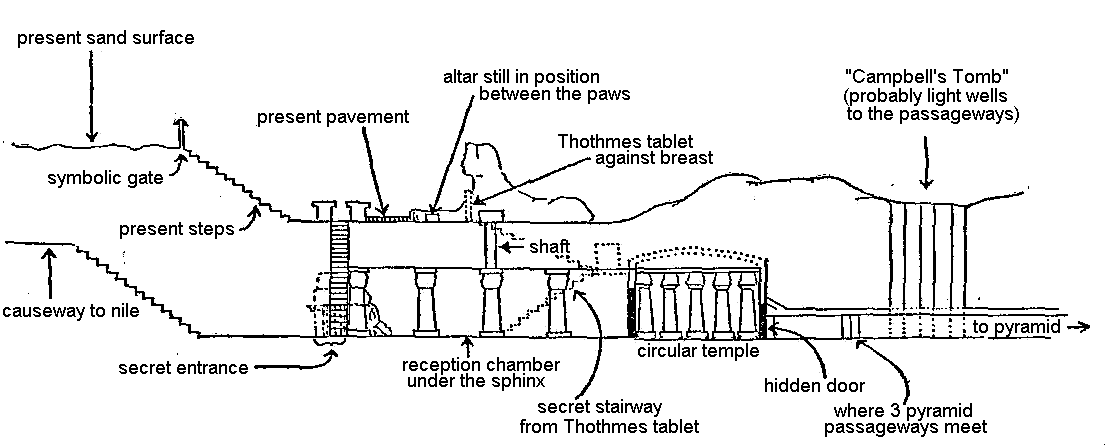
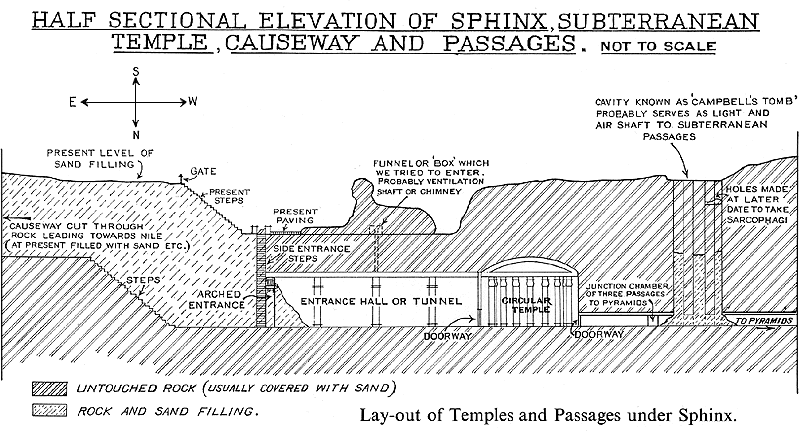
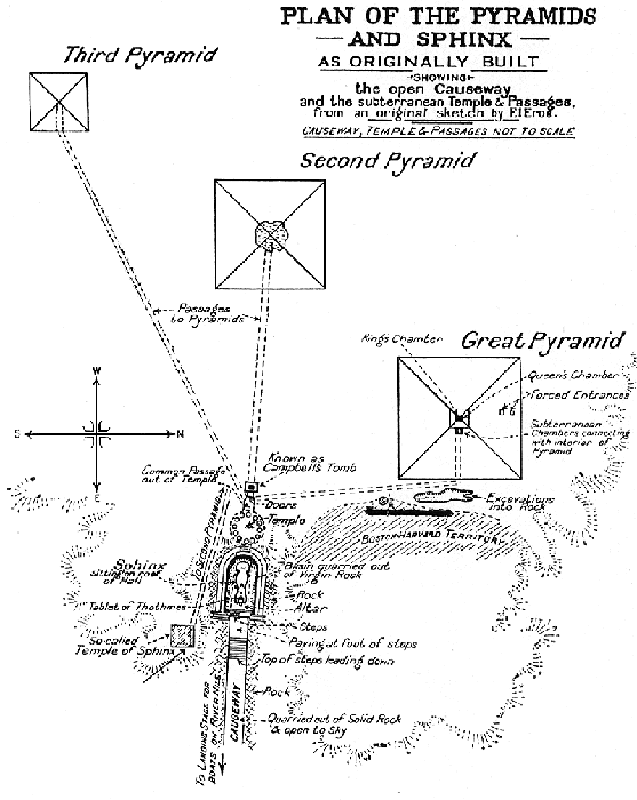
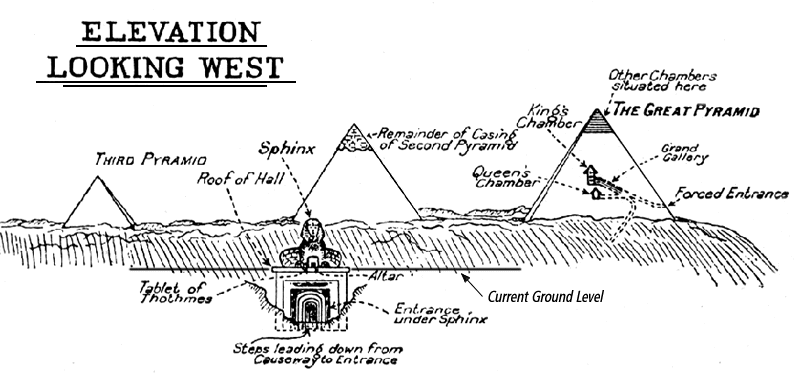
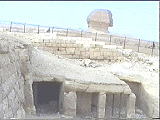
Side doors lead to underground passageways.
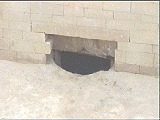
Underground passageways and chambers in front and rear
Two passages were found in 1978 - one behind the head of the Sphinx and another on the tail. Far from leading to the Pyramids, however, these tunnels merely led downwards under the monument and were made during the past century by treasure-hunters.
During the past two centuries many have come to study and excavate the monument. These include French scholars accompanying Napoleon's army in 1798, Caviglia in 1816, H. Vyse in 1840, Mariette in 1853, Kamal and Daressy in 1909 and Baraize in 1926. It was Baraize who first began restoration work, by renovating the head using cement, and clearing the sand completely around the Sphinx.
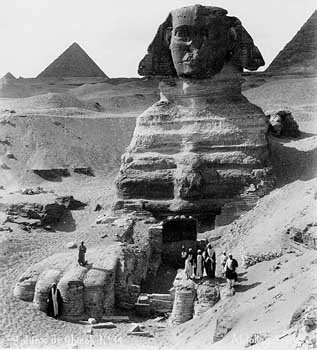
Restoring the paws
Another problem is caused by the rising water table, which evaporates, leaving salts behind. These salts react with the limestone, causing it to become powdery and to crumble. Pollution from the nearby city of Cairo, together with heat, wind, sand and humidity are all agents in the monument's slow process of disintegration.
In 1982, stones were lost from the north paw and in 1988 a large stone fell from the Sphinx's shoulder. From 1989 onwards, the restoration project entered a more enlightened phase, with more thought being given to the monument's long-term preservation in its original form.
The restoration project was planned in three stages: first, to restore the southern side, next the northern side and the chest and lastly, to protect the whole monument from the ravages of the elements.
The large old stones and cement were removed from the southern side and replaced with new stones from a quarry at Helwan, which contains rock consistent with the limestone of the original structure. Mortar made of lime and sand replaced the cement as a fixative, and the chest was protected by a limestone course.
The Institute of Astronomy and Geophysics at Helwan conducted important studies on the level of the water table, and this has been found to be seven metres below the base of the monument. An electronic weather station nearby at the Getty Institute now records wind, heat and humidity, and a study of the bedrock under the Sphinx has been undertaken by the Engineering Faculty at Cairo University.

A routine excavation has uncovered ancient walls surrounding the Great Sphinx of Giza, Egypt's Supreme Council of Antiquities (SCA) announced. The walls were likely built to protect the Sphinx from blowing sand, said SCA Secretary-General Zahi Hawass, who is overseeing the excavation.
During routine digging, SCA researchers found two segments of mud wall on the Giza Plateau, where the pyramids of Giza and the Sphinx stand. Both walls stand just under 3 feet (1 meter). One runs north-south and is 282 feet (86 meters) long, while the other runs east-west and is 151 feet (46 m) long. The walls are part of a larger enclosure previously found north of the Sphinx. As told in ancient Egyptian texts, King Thutmose IV once went on a hunting trip near the Sphinx.
After the trip, he dreamt that the Sphinx wanted him to clear the sand surrounding its body. According to Thutmose, the Sphinx promised that if he restored the statue, he'd become king of Egypt. So Thutmose had the sand cleared and built a wall to preserve the Sphinx. Until now, researchers thought the wall was only built on the northern side of the Sphinx. The new finding disproves that theory.
The researchers also found a third wall to the east of the temple of King Khafre, the builder of the second-largest pyramid in Giza and the likely builder of the Sphinx. According to Hawass, the wall may be part of the settlement that grew up around King Khafre's pyramid after the monarch's death around 2532 B.C. In this village, priests and officials oversaw the mortuary cult of the dead king.
Khafre's mortuary cult remained strong until the end of Egypt's Old Kingdom around 2143 to 2134 B.C. After that, initial excavations suggest the village was abandoned, said Essam Shehab, the supervisor of the Khafre's valley temple excavation. Excavations continue on the Thutmose IV enclosure wall, according to the SCA. The archeologists are keeping an eye out for other secrets still hidden in the sand.